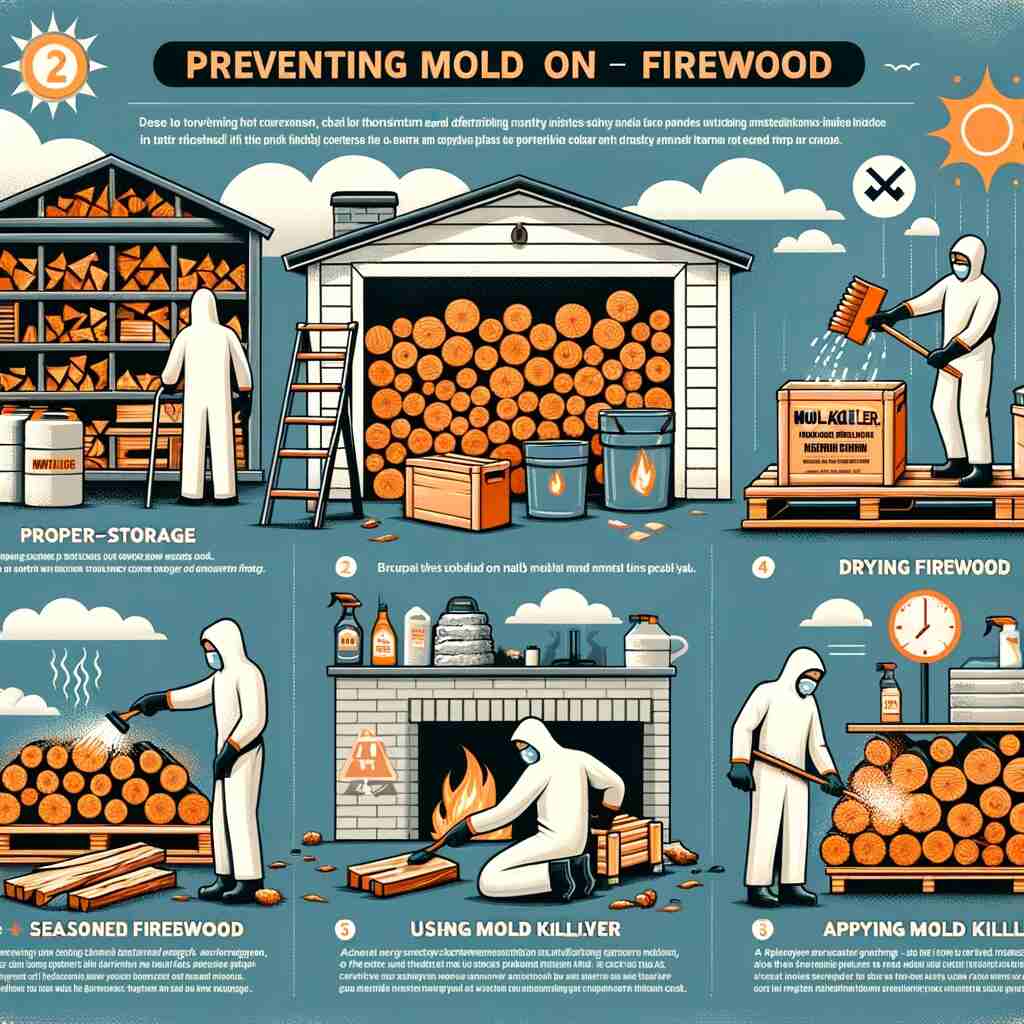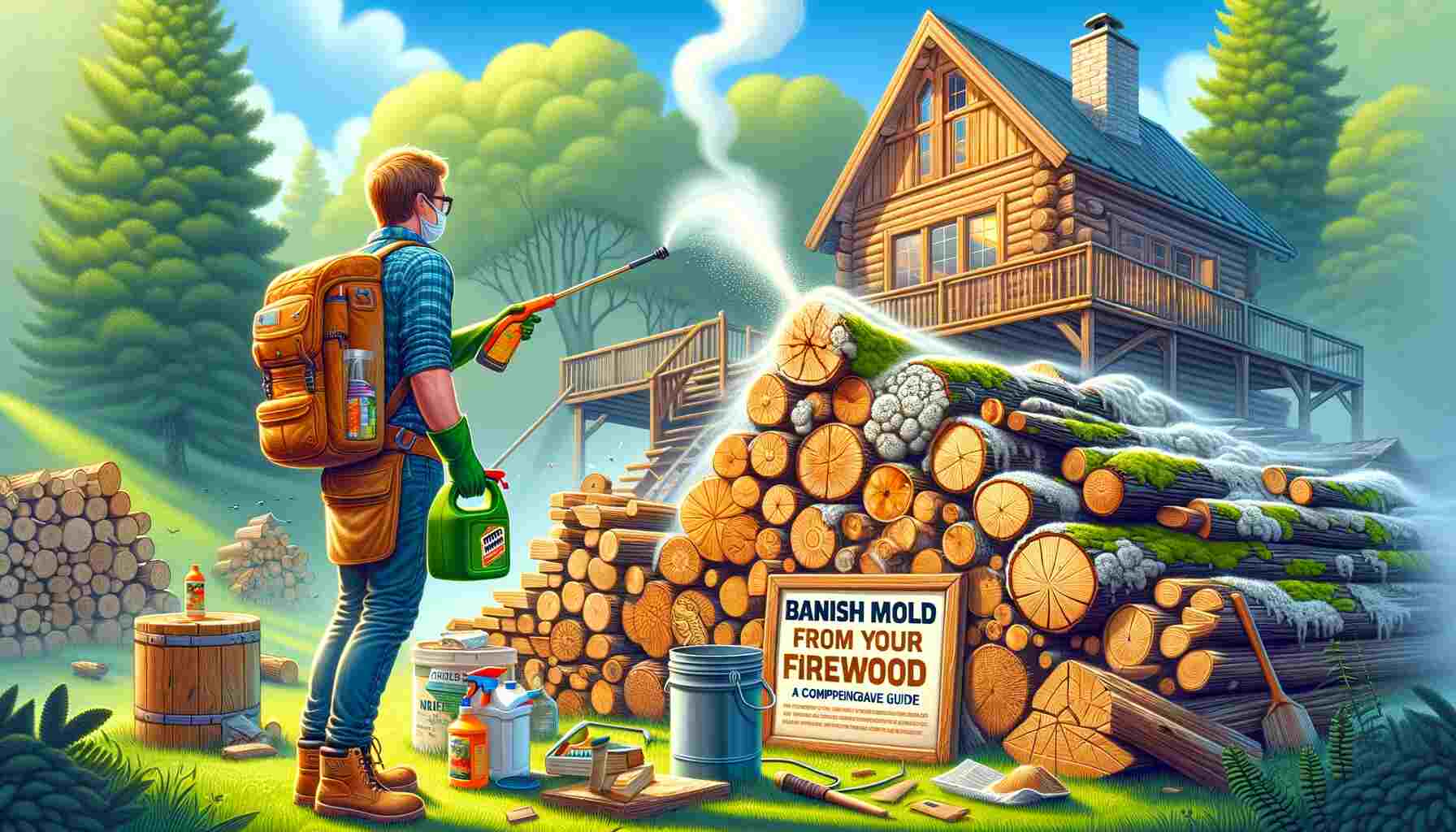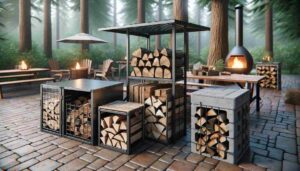Welcome to our latest guide where we delve into the crucial topic of preventing and eliminating mold on firewood. Mold on firewood is not just unsightly; it can pose health risks and affect the burning quality of the wood. Fortunately, with the right strategies, you can keep your firewood in top condition. Let’s explore the steps you need to take.

1. Start with Proper Preparation
The first step in mold prevention begins with how you prepare your firewood. Proper preparation not only reduces the risk of mold growth but also ensures a more efficient and cleaner burning experience.
Splitting
When it comes to splitting your firewood, remember that smaller pieces of wood dry out faster and more evenly, which reduces the likelihood of mold growth. Ideally, you should aim for pieces that are around 16-18 inches in length. This size is manageable and allows for proper air circulation during the drying process.
Drying
Properly drying firewood is crucial. If possible, cut and split your wood in spring or early summer so it has enough time to dry before the colder months arrive. Seasoning firewood can take anywhere from 6 months to a year, depending on factors like wood type and climate. The key is to allow the wood to reach a moisture content of around 20% or less.
Handling Moldy Wood
If you encounter mold on already-cut wood, don’t panic. Cleaning it with a mold-killing product or a mild bleach solution can be effective. However, safety should always be a priority. Wear gloves and goggles during this process to protect yourself from potential health hazards associated with mold spores.
2. Seal Against Moisture
Moisture is the enemy when it comes to firewood. Even well-seasoned wood can develop mold if it becomes damp. To protect your firewood from moisture, consider using a mold-free sealant. Here are some key points to keep in mind:
Moisture Barrier
A mold-free sealant acts as a barrier against moisture, which is a primary factor in mold growth. It helps to lock in the wood’s natural moisture content while preventing additional moisture from penetrating the wood.
Wood Type Specifics
Different types of wood may require different types of sealants. For instance, the sealant suitable for oak might not be appropriate for pine. Be sure to choose a sealant that is compatible with your specific wood type for maximum effectiveness.
3. Dry and Cool Storage
Where you store your firewood significantly impacts its susceptibility to mold. A dry, cool place, away from direct sunlight and excess moisture, is ideal. This environment prevents the conditions mold needs to thrive. Here are some storage considerations:
Location
Choose a storage location that is dry, cool, and preferably with some exposure to sunlight. Sunlight naturally inhibits mold growth. Avoid damp areas or places with poor air circulation, as these can contribute to mold development.
Elevation
Keep firewood off the ground to avoid moisture absorption. Using pallets or racks as a base is a great way to elevate your wood stack and prevent direct contact with the ground.
4. Use Seasoned Firewood
The importance of using seasoned firewood cannot be overstated. Seasoned wood has reduced moisture, making it less prone to mold. Plus, it’s a more efficient and safer burning option. Here are some benefits of using seasoned firewood:
Reduced Moisture Content
Seasoned firewood has significantly lower moisture levels compared to freshly cut wood. This reduction in moisture content is a key factor in preventing mold growth.
Quality Burning
Besides reducing mold risk, seasoned wood burns more efficiently and produces less smoke. This not only makes your fires more enjoyable but also contributes to better air quality around your home.
5. Apply a Mold Killer
For existing mold, applying a mold killer to the wood’s surface is a necessary step. Ensure you adhere to safety guidelines and use these chemicals in well-ventilated areas. Here’s what you need to know:
Choosing the Right Product
Select a mold killer suitable for wood. Read the label carefully for application instructions and safety precautions. Different products may have different application methods, so it’s important to follow the manufacturer’s recommendations.
Application Process
Apply the product evenly and allow it to dry as per the instructions. Ensure you do this in a well-ventilated area to minimize your exposure to the chemicals. Always wear appropriate protective gear to safeguard your health.
6. Stacking and Sun Exposure
Properly stacking and curing your firewood is critical to preventing mold growth. Here’s how you can do it effectively:
Sunlight as a Mold Deterrent
As mentioned earlier, sunlight naturally inhibits mold growth. Position your wood stack in a place where it can get maximum sunlight exposure. This not only helps in drying out the wood but also acts as a deterrent to mold development.
Effective Stacking
When stacking your firewood, make sure to arrange the pieces in a way that allows air to circulate freely around each piece. This promotes faster drying and prevents mold. Avoid stacking wood too tightly, as this can trap moisture.
7. Regular Checks and Protective Measures
Regularly inspecting your firewood is crucial, especially after wet or humid periods. When handling moldy wood, protective gear like gloves and a mask is essential to avoid inhaling harmful spores. Here’s what you need to know:
Routine Checks
Make it a habit to inspect your firewood regularly, particularly after rainy or high humidity periods. Early detection of mold can prevent it from spreading and damaging your entire woodpile.
Safe Handling
Always wear protective gear when handling moldy wood. This includes gloves to protect your hands, goggles to shield your eyes, and a mask to prevent inhalation of mold spores. Safety should be your top priority.
8. Chemical Treatments: A Last Resort
In severe cases where mold is deeply entrenched in the wood, you may consider using chemical treatments as a last resort. Here are some important considerations:
Natural Options
Vinegar is a less harsh option than bleach and can be effective against mold. It is a safer choice for both you and the environment. However, it may require more time and repeated applications to fully eliminate the mold.
Bleach Solutions
If opting for bleach, use it sparingly and dilute it properly to avoid damaging the wood. Bleach can be effective in killing mold, but it should be a last-resort option due to its harshness.
9. Disposing Severely Moldy Wood
Sometimes, the best course of action with heavily moldy wood is to dispose of it. This prevents the spread of mold spores and maintains the quality of your firewood stack. Here’s how to go about it:
Assessing Wood Condition
Examine the wood carefully to assess the extent of mold infestation. If the wood is heavily mold-infested, it might be safer and more practical to discard it rather than attempting to salvage it.
Disposal Methods
Dispose of moldy wood responsibly, considering local regulations and environmental impact. Depending on your area, this may involve contacting your local waste disposal service or recycling facility for guidance on proper disposal methods.
10. Physical Mold Removal
Sun-drying the wood and physically removing mold with a stiff brush can be effective. This should be done outdoors to prevent the spread of mold spores. Here’s how to approach physical mold removal:
Brushing Off Mold
Use a stiff brush to physically remove mold from the surface of the wood. Be thorough but gentle to avoid damaging the wood. Make sure to perform this task in a well-ventilated outdoor area to prevent the release of mold spores indoors.
Sun-Drying
After brushing off the mold, expose the wood to sunlight to dry out any residual moisture and inhibit further mold growth. Sunlight is a natural mold deterrent and can help ensure that the wood remains mold-free.
Statistics
One notable statistic is that approximately 4.6 million cases of asthma in the U.S. are estimated to be linked to dampness and mold exposure in homes. This highlights the significance of managing mold, not just in firewood but in living environments generally, due to its potential impact on respiratory health (Realtime Labs, 2007). Including such data can provide you with a broader understanding of the importance of preventing mold growth.
Conclusion
In conclusion, the key how to get rid of mold on firewood is a combination of preventive care, regular inspection, and prompt action when mold is detected. With these practices, you can enjoy a safe and efficient fire experience.
Remember, mold in firewood isn’t just a cosmetic issue. It can have implications for your health and your home’s air quality. Take the necessary steps to ensure your firewood is clean, dry, and ready to keep you warm and cozy.
We hope this guide has been informative and helpful. Stay tuned for more useful tips and tricks on maintaining your home and living a healthy, comfortable life!
FAQs
Here are some additional questions and concerns, along with answers to address them:
Q1: Can I still use moldy firewood if I burn it at a high temperature?
A1: While burning moldy wood at a high temperature can kill mold spores, it’s not recommended due to health concerns. Inhaling mold spores can be harmful, and the odor produced by burning moldy wood may not be pleasant.
Q2: Is there a way to prevent mold on firewood during transportation or delivery?
A2: To prevent mold during transportation, ensure the firewood is properly covered and protected from rain and moisture. Use tarps or waterproof covers, and store the wood in a dry, well-ventilated area upon delivery.
Q3: Can I store firewood indoors to prevent mold?
A3: Storing firewood indoors is generally not recommended as it can introduce mold spores into your living space. If you must store it indoors temporarily, keep it in a designated, well-ventilated area and maintain proper humidity levels.
Q4: Is there a natural way to prevent mold on firewood without using chemicals?
A4: Yes, several natural methods can help prevent mold, including proper seasoning, effective stacking for airflow, and maximizing sun exposure. These methods reduce the need for chemical treatments.
Q5: Can mold on firewood spread to my house or other wooden structures?
A5: While mold on firewood won’t necessarily spread directly to your house, it can release mold spores that may affect indoor air quality. To prevent this, always inspect and handle moldy wood with care to minimize the risk of spore release.
Q6: What’s the best way to dispose of moldy firewood responsibly?
A6: To dispose of moldy firewood responsibly, check local regulations for guidance. Some areas may allow you to burn it in an outdoor fire or dispose of it with yard waste. Avoid dumping moldy wood in a way that could contaminate the environment.
Q7: How can I tell if my firewood is properly seasoned and ready for use?
A7: Properly seasoned wood should feel lighter, have visible cracks or splits, and make a sharp, echoing sound when two pieces are struck together. You can also use a moisture meter to ensure the moisture content is around 20% or lower.
Q8: Can I prevent mold on firewood by applying essential oils or natural remedies?
A8: While some essential oils may have mold-inhibiting properties, they are not as effective as other methods like proper drying and sealing. If you choose to use essential oils, research their effectiveness and application methods carefully.










